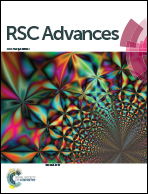Preparation of 3D pompon-like titanate nanotube microspheres and their adsorption properties on cationic dyes
Abstract
Hierarchical 3D pompon-like microspheres built with titanate nanotubes have been successfully synthesized by a simple hydrothermal method in the presence of CH3COOH and H2O2. The samples have been characterized by X-ray powder diffraction, scanning electron microscopy, transmission electron microscopy, X-ray photoelectron spectroscopy and nitrogen adsorption and desorption, zeta potential etc. techniques. The pompon-like microspheres consist of titanate nanotubes twisted each other. These nanotubes are 7 nm in inner diameter and 17 nm in outer diameter, and its length can reach several tens micrometer. The hierarchical nanotube microspheres have a high specific surface area of 217.98 m2 g−1, and it exhibits excellent adsorption performance toward cationic dyes. 50–60% measured dyes could be removed in 10 min; after 30 min, the removal rate of neutral red, methylene blue, malachite green and crystal violet could reach 76%, 79%, 77% and 55% respectively, and the saturated adsorption capacities of these four dyes are 401.8, 382.07, 361.95, and 322.5 mg g−1 at 25 °C, respectively. The adsorption kinetics has been studied, it indicates that the adsorption data fits perfectly with the pseudo-second-order kinetics, and the controlling step of adsorption process should be chemisorption.


 Please wait while we load your content...
Please wait while we load your content...